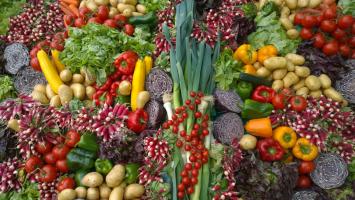![Save this Recipe. Save this Recipe]() Save Save
How to Make Lemongrass Carrot SoupSERVINGS: 4 PREP TIME: 15 MINUTES COOK TIME: 35 MINUTES
INGREDIENTS
| 4 whole | |
| 16 g | |
| 3 c | |
| 2 tbsp | |
| 1/2 inch | |
| 1 tbsp | |
| 1 tbsp | |
| 1 tsp | |
| 1 c | |
PREPARATION OF THIS HEALTHY RECIPE
1. In large pot, heat ghee on medium.
2. Add diced onion and gently fry for about 5 minutes or until translucent.
3. Remove tough outer skin of the lemongrass and pound with a rolling pin (to release essential oils).
4. Add to pot along with ginger, turmeric and chopped carrots and continue to sautee for 5-10 minutes.
5. Add coconut milk and vegetable stock and simmer for 20 minutes until carrots are tender.
6. Remove lemongrass, stir in maple syrup and blend to smooth consistency.
7. Garnish with chopped cilantro leaves.
How Does This Ayurvedic Recipe Improve Wellness?
CLINICAL AYURVEDIC REVIEW
The fragrant essential oils of lemongrass will fill your kitchen with the scent of Asian cooking as you prepare this 'Lemongrass Carrot Soup'. Put some relaxing music on and allow the aromatic nature of this meal calm the mind as you unwind. The vibrant orange of carrot and delicate cilantro greens will brighten up your evening meal.
If you tend to feel stressed out, irritable or experience skin inflammation (particularly in the summer months), you may have too much internal heat. This meal packs an anti-inflammatory punch that will pacify Pitta and cleanse overheated, toxic blood leaving you feeling cool, calm and collected.
Aromatic and diaphoretic, lemongrass relaxes the peripheral circulatory system and clears excess heat from the blood. Its light and dry nature and pungent taste means is stokes the digestive fire and reduces the build up of digestive toxins. However its cooling energy means it is still suitable for Pitta. Combined with carrots and turmeric, renowned blood purifiers and anti-inflammatory foods, this meal is most suitable in spring and summer to leave you feeling fresh and energized.
AYURVEDA'S GUIDE TO VITALITY & WHOLESOME NOURISHMENT
Your Ayurvedic diet is tailored to your individual body and your specific imbalances.
With an Ayurvedic diet you feel joy and satisfaction because what you are eating truly nourishes and balances you.
Disease results from diets and lifestyles that are incompatible with your nature.
By eating a personalized diet matched to your body, you experience optimal health.
See How it Works.
Is Lemongrass Carrot Soup Good for My Ayurvedic Diet?
Find out by taking this free, easy quiz.
You'll learn your body type, and whether 'Lemongrass Carrot Soup' is a good fit.
Complete the basic quiz in 1 minute, or go deeper with additional quizzes at your own leisure to learn more about your body.
See a complete list of all biocharacteristics.
INCREASES![Guna Help]()
Increases These Biocharacteristics (Gunas)
Functional Ayurveda helps you assess imbalances through 20 main biocharacteristics
(gunas).
Aggravating these characteristics weakens your body and causes imbalance.
By knowing which characteristics are habitually imbalanced in your body, you will be able to identify and correct imbalances before you get sick.
Every characteristic has an opposite which balances it (i.e. hot balances cold).
You restore balance by favoring diet and lifestyle choices that increase the opposite characteristic.
Learn More
| DRY ![Dry Dry]() ABOUT DRY BIOCHARACTERISTIC ABOUT DRY BIOCHARACTERISTIC
Dry is identified by lack of moisture, lack of fat, or anything that causes diuresis.
LEARN MORE ABOUT DRY HOT ![Hot Hot]() ABOUT HOT BIOCHARACTERISTIC ABOUT HOT BIOCHARACTERISTIC
Hot is identified by increased body temperature, metabolism, or inflammation.
LEARN MORE ABOUT HOT LIQUEFIED ![Liquefied Liquefied]() ABOUT LIQUEFIED BIOCHARACTERISTIC ABOUT LIQUEFIED BIOCHARACTERISTIC
Substances that thin fluids (lower viscosity of blood plasma). These may include blood thinners or mucolytic herbs.
LEARN MORE ABOUT LIQUEFIED | TASTES![Taste Help]()
The 6 Tastes
Taste is used to sense the most basic properties and effects of food.
Each taste has a specific medicinal effect on your body.
Cravings for food with certain tastes indicate your body is craving specific medicinal results from food.
Taste is experienced on the tongue and represents your body's reaction to foods.
Sweet taste causes physical satisfaction and attraction whereas bitter taste causes discomfort and aversion.
Kapha should use less sweet taste while Vata and Pitta would benefit from using more sweet taste.
One of the first signs of illness is that your taste and appetite for food changes.
The six tastes are sweet, sour, salty, pungent, bitter, and astringent.
Do you crave foods with any of the tastes below?
Learn More
| SWEET ![Sweet Sweet]() ABOUT SWEET BIOCHARACTERISTIC ABOUT SWEET BIOCHARACTERISTIC
Sweet refers to anything builds tissue, including macronutrients such as carbohydrates, proteins and fats.
LEARN MORE ABOUT SWEET | DOSHAS![Dosha Help]()
The Three Doshas / Body Types
According to the biocharacteristic theory of medicine,
people tend to get sick, over and over again, due to habitual causes and imbalances that are unique to the person.
Your body type summarizes this tendency, showing you the 'type' of conditions and imbalances that frequently challenge your health & wellness.
Using body type, you can also identify remedies likely to improve your strength and resiliency.
Your body type identifies physical and mental characteristics as well as your personal strengths and weaknesses.
The calculation of your body type is based on your medical history.
The 3 functional body types
(doshas),
are Catabolic (Vata), Metabolic (Pitta), and Anabolic (Kapha).
Catabolic individuals tend to break down body mass into energy. They are easily stimulated, hyperactive, underweight and dry.
Metabolic individuals tend to burn or use energy. They tend to be rosy-cheeked, easily irritated, focused, driven, and easily inflamed.
Anabolic individuals tend to store energy as body mass. If they store too much energy, they could gain weight easily and have congestion. Anabolic people tend to be stable and grounded.
Learn More
| | HAS THE FOLLOWING | Subtaste:
Aromatic AROMATIC
Herbs or spices with volatile essential oils that present strong aromas. Aromatic oils shock, refresh and numb tissue, with the end result of relaxing, opening and clearing stagnant fluids in tissues.
SEE ALL 'AROMATIC' FOODS / HERBS , Bland BLAND
Bland means doesn't have much taste. In Chinese medicine, bland taste refers to afood without little macronutrients, such as cabbage, radish or bok choy.
SEE ALL 'BLAND' FOODS / HERBS
Tissue (dhatu):
, , |
|
Medicinal Benefits, Uses & Herbal Actions of Lemongrass Carrot Soup ![Help]() Experiences are Personal
Experiences vary according to the person and constitution. Individual results may vary.
The list of herbal-actions below has not be approved by the FDA and should not be used to treat a medical condition.
Nerve Relaxant Grounding NERVE-RELAXANT-GROUNDING
Encourages feelings of stability and heaviness. Makes you feel settled, mentally relaxed. Mildly sedates the nervous system to ease stress. Can bring a spacey or anxious person back to earth. Reduces agitation, irritation, stress and racing thoughts.
SEE ALL 'NERVE-RELAXANT-GROUNDING' FOODS / HERBS , , Nervine NERVINE
Balances the nervous system. They can help with stress, memory, early alzheimer's, and even chronic pain. Often they are aromatic in nature.
SEE ALL 'NERVINE' FOODS / HERBS , Brain Tonic BRAIN-TONIC
An herb that strengthens the brain and thereby enhances memory or other cognitive functions and improves mental stamina or stability.
SEE ALL 'BRAIN-TONIC' FOODS / HERBS , Warms Chest WARMS-CHEST
Warms the chest and lungs, clearing mucus and allowing for clear breathing. Often these herbs are hot, aromatic, and pungent.
SEE ALL 'WARMS-CHEST' FOODS / HERBS Antioxidant ANTIOXIDANT
An antioxidant is a molecule that inhibits oxidation. Oxidation is a chemical reaction that can produce free radicals that lead to a chain reaction causing damage or death to cells. Antioxidants terminate these oxidation reactions.
SEE ALL 'ANTIOXIDANT' FOODS / HERBS , Vasodilator VASODILATOR
A vasodilator is an herb that widens the blood vessels by the relaxation of smooth muscle cells within the vessel walls, thereby increasing circulation systemically or to a local area.
SEE ALL 'VASODILATOR' FOODS / HERBS Diuretic DIURETIC
Herbs that promote urine formation, thereby flushing the kidneys and urinary tract while eliminating any excess water retention. As diuretics reduce water retention, they are often used to reduce blood pressure.
SEE ALL 'DIURETIC' FOODS / HERBS Constituents: Nitric Oxide NITRIC-OXIDE
Improves circulation by dilating blood vessels. Protects blood vessels from damage. Improves athletic performance, libido, immunity, and brain health.
SEE ALL 'NITRIC-OXIDE' FOODS / HERBS , Flavonoids FLAVONOIDS
Flavonoids are a colorful type of polyphenol. As all polyphenols, they have a strong antioxidant effect. Many flavonoids have an anti-inflammatory, and/or antiallergen effect.
SEE ALL 'FLAVONOIDS' FOODS / HERBS , 5a Reductase Inhibitor, Fats, , Soluble Fiber, Vitamin A, Vitamin K, , Beta Carotene, Carbohydrate |
Foods with a Similar Nature to Lemongrass Carrot Soup
Beets
Beets has these Actions in Common
Anti-inflammatory, Nutritive, Stimulates-energy, Internal-detoxicant, Relaxes-eyes, Vasodilator, Nerve-relaxant-grounding, Satisfies-stomach
LEARN MORE
Ginger (Fresh)
Ginger (Fresh) has these Actions in Common
Brain-tonic, Nervine, Vasodilator, Digestive, Refreshing, Anti-inflammatory, Internal-detoxicant, Stimulates-energy
LEARN MORE
Turmeric
Turmeric has these Actions in Common
Anti-inflammatory, Digestive, Vasodilator, Antioxidant, Flushes-sinuses, Warms-chest, Brain-tonic, Internal-detoxicant
LEARN MORE
Ajwain
Ajwain has these Actions in Common
Diuretic, Refreshing, Internal-detoxicant, Stimulates-energy, Digestive, Nervine, Vasodilator
LEARN MORE
Nigella (black cumin)
Nigella (black cumin) has these Actions in Common
Diuretic, Stimulates-energy, Anti-inflammatory, Internal-detoxicant, Vasodilator, Digestive, Nervine
LEARN MORE
Acai
Acai has these Actions in Common
Brain-tonic, Refreshing, Anti-inflammatory, Nerve-relaxant-grounding, Relaxes-eyes, Antioxidant, Nutritive
LEARN MORE
Sorghum Flour
Sorghum Flour has these Actions in Common
Anti-inflammatory, Nerve-relaxant-grounding, Satisfies-stomach, Brain-tonic, Nutritive, Diuretic, Relaxes-eyes
LEARN MORE
Daikon Radish
Daikon Radish has these Actions in Common
Diuretic, Stimulates-energy, Anti-inflammatory, Flushes-sinuses, Warms-chest, Digestive, Refreshing
LEARN MORE
Fenugreek
Fenugreek has these Actions in Common
Digestive, Nervine, Diuretic, Nutritive, Anti-inflammatory, Internal-detoxicant, Stimulates-energy
LEARN MORE
Allspice
Allspice has these Actions in Common
Internal-detoxicant, Vasodilator, Anti-inflammatory, Nervine, Warms-chest, Digestive, Stimulates-energy
LEARN MORE
Rosemary
Rosemary has these Actions in Common
Internal-detoxicant, Vasodilator, Brain-tonic, Nervine, Warms-chest, Digestive, Stimulates-energy
LEARN MORE
Herb Supplements with a Similar Nature to Lemongrass Carrot Soup
Amalaki
Amalaki has these Actions in Common
Nutritive, Refreshing, Relaxes-eyes, Anti-inflammatory, Stimulates-energy, Antioxidant, Brain-tonic, Digestive, Internal-detoxicant
LEARN MORE
Holy Basil Leaf (Tulsi)
Holy Basil Leaf (Tulsi) has these Actions in Common
Vasodilator, Anti-inflammatory, Warms-chest, Diuretic, Internal-detoxicant, Nerve-relaxant-grounding, Nervine, Refreshing, Stimulates-energy
LEARN MORE
Deodar (Himalayan Cedar, Devadaru)
Deodar (Himalayan Cedar, Devadaru) has these Actions in Common
Digestive, Diuretic, Nervine, Refreshing, Stimulates-energy, Vasodilator, Warms-chest, Anti-inflammatory
LEARN MORE
Punarnava
Punarnava has these Actions in Common
Antioxidant, Digestive, Diuretic, Internal-detoxicant, Nerve-relaxant-grounding, Stimulates-energy, Vasodilator, Anti-inflammatory
LEARN MORE
Ginkgo
Ginkgo has these Actions in Common
Antioxidant, Brain-tonic, Diuretic, Internal-detoxicant, Nervine, Vasodilator, Anti-inflammatory
LEARN MORE
Dong Quai
Dong Quai has these Actions in Common
Anti-inflammatory, Antioxidant, Digestive, Internal-detoxicant, Nervine, Stimulates-energy, Vasodilator
LEARN MORE
Ashwagandha
Ashwagandha has these Actions in Common
Nutritive, Anti-inflammatory, Antioxidant, Brain-tonic, Diuretic, Nerve-relaxant-grounding, Nervine
LEARN MORE
Nasya Oil
Nasya Oil has these Actions in Common
Nervine, Refreshing, Stimulates-energy, Vasodilator, Brain-tonic, Flushes-sinuses
LEARN MORE
Chandraprabha Vati
Chandraprabha Vati has these Actions in Common
Internal-detoxicant, Nervine, Vasodilator, Anti-inflammatory, Digestive, Diuretic
LEARN MORE
Kava Kava
Kava Kava has these Actions in Common
Anti-inflammatory, Digestive, Diuretic, Internal-detoxicant, Nerve-relaxant-grounding, Nervine
LEARN MORE
Hawthorne Berry & Flower
Hawthorne Berry & Flower has these Actions in Common
Vasodilator, Anti-inflammatory, Antioxidant, Digestive, Diuretic, Internal-detoxicant
LEARN MORE
![]()
Joyful Belly is a recognized school of biocharacteristics medicine.
Eat Well for Life With Ayurveda: Balance Your Dosha
Love our recipes? Discover how to balance your diet for only $35 with this popular short course.
GET THE ECOURSE
![About John Joseph Immel]()
About the Author
John Immel, the founder of Joyful Belly, teaches people how to have a
healthy diet and lifestyle with Ayurveda biocharacteristics.
His approach to Ayurveda is clinical, yet exudes an ease which many find enjoyable and insightful.
John also directs Joyful Belly's School of Ayurveda,
offering professional clinical training in Ayurveda for over 15 years.
John's interest in Ayurveda and specialization in digestive tract pathology was inspired by a complex digestive disorder acquired from years of international travel,
as well as public service work in South Asia.
John's commitment to the detailed study of digestive disorders reflects his zeal to get down to the roots of the problem.
His hope and belief in the capacity of each & every client to improve their quality of life is nothing short of a personal passion.
John's creativity in the kitchen and delight in cooking for others comes from his family oriented upbringing.
In addition to his certification in Ayurveda, John holds a bachelor's degree in mathematics from Harvard University.
John enjoys sharing Ayurveda within the context of his Catholic roots,
and finds Ayurveda gives him an opportunity to participate in the healing mission of the Church.
Jesus expressed God's love by feeding and healing the sick.
That kindness is the fundamental ministry of Ayurveda as well.
Outside of work, John enjoys spending time with his wife and 6 kids, and pursuing his love of theology, philosophy, and language.
Read more
|

 Save
Save




 1 rating, 549 likes
1 rating, 549 likes




 Sign in to review this recipe
Sign in to review this recipe











 Print
Print
 On MeWe
On MeWe On Pinterest
On Pinterest On Facebook
On Facebook On Twitter
On Twitter On WhatsApp
On WhatsApp On Email
On Email













